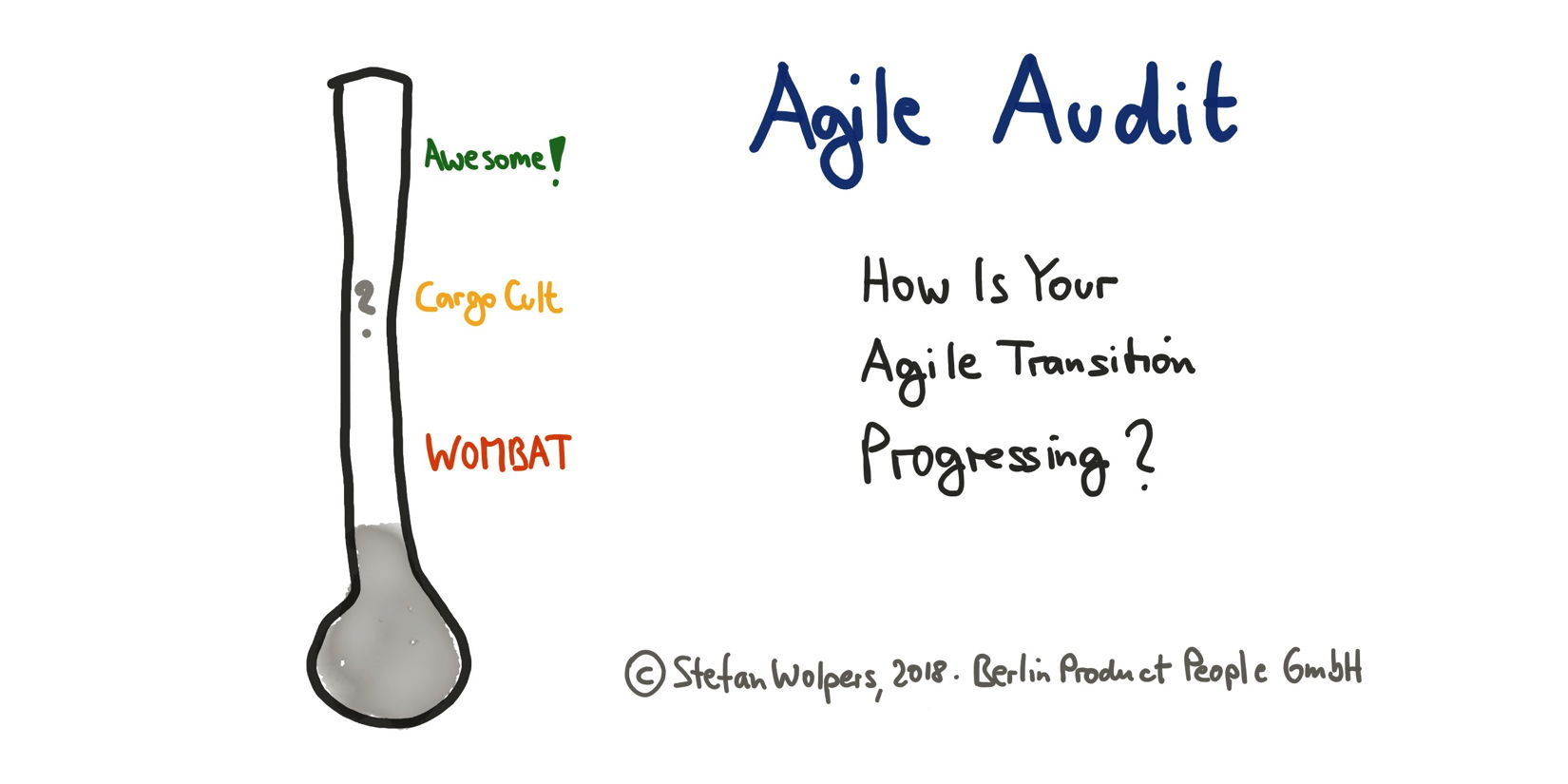Agile Audit by Berlin Product People GmbH
Is your agile transformation yielding results? Are there untapped opportunities to improve the return on investment? Or are you wasting resources—time, money, and creativity—on a futile effort? An agile audit provides answers to these pressing questions.
The purpose of an agile audit is to uncover the state of the agile transition of your organization, based on the agile principles of transparency, inspection, and adaptation. The outcome of an agile audit is both of a quantitative and qualitative nature. One the one side, there are metrics for tracking the progress of the teams’ mastery of agile practices. Then there are assessments from stakeholders across the organization on the state of the agile transformation. Both information sources are then molded into a recommendation on how to proceed with the agile transformation of your organization. The resulting report will indicate areas where further investments in training would be useful, for example, technical expertise at the team level. The report will also identify areas were additional spendings may like not yield a return on investment.

Why an Agile Audit Is a Sound Investment
Supposedly, becoming agile is a journey, not a destination, which is a convenient narrative if the viability of your consultancy depends on selling men and materiel. The fuzzier the objective of an agile transition the less likely there will be an agile audit addressing the return on investment question the customer might have. Moreover, a fuzzy goal such as ‘we want to become an agile organization’ is probably the reason for applying the same methodologies indiscriminately to every organization. This proceeding resembles a one-size-fits-all approach for agile transitions that is scalable and hence lucrative for the consultancy or service provider but likely to fail.
Becoming Agile, Late Majorities, and Laggards
InfoQ applies the ‘Crossing the Chasm’ metaphor to engineering practices, thus covering a part of the agile movement to create learning organizations. Its recent ‘Engineering Culture and Methods InfoQ Trends Report – January 2018’ found that new converts to Scrum, for example, will recruit themselves most likely from the late majority and laggards. (The early majority of organizations is already adopting Scrum derivatives and advanced engineering practices such as BDD.)

Copyright notice: InfoQ, 2018. All right reserved.
What if not every organization embarking on a transition to agile practices is meant to become a teal organization or a holacracy in the end? What if being late to the agile transition party is rather a deliberate choice than a manifestation of hubris, ignorance or leadership failure?
Regarding the late majority and laggards, there are two hypotheses:
- Not every—late majority or laggard—organization embarking on an agile transition would benefit from automatically following the beaten path of preceding organizations. Why strive to become a holacracy if there is no value for customers to be gained? (For example, there are organizations operating in highly regulated markets.)
- Many of the innovators, early adopters, and early majority organizations would benefit from external feedback loops in the form of an agile audit, too. The majority of these organizations are anyway operating somewhere on the product delivery side of the agile equation. They have never progressed to embracing business agility as an organizational concept. Moreover, they probably overspent on their agile transitions as they missed to define a goal at the beginning of their journey. Note, it is not in the interest of a consultancy supporting clients with agile transitions to make itself redundant in the process. (A real moral hazard.)
The Agile Audit in Practice
The principle structure of an agile audit focuses on value streams and works as follows:
- At the team level, the agile audit starts with an self-assessment of the teams’ mastery of agile practice. We use the Agile Fluency™ Team Diagnostic for this purpose, extended by meta retrospective which each team.
- We run an anonymous questionnaire based on the Agility Assessment Framework to gain an understanding of the inside perception of the agile transition that different groups of stakeholders and participants have.
- We run a meta retrospective with team members from the engineering side to get an understanding of the current organizational issues concerning technical excellence. (Business Agility requires technical excellence.)
- We run a meta retrospective with stakeholders from the business side to get an understanding of the current problems concerning the level of business agility and organizational excellence.
- We run interviews with selected individuals from all ranks.
- We aggregate all the information into a report of the current state of the agile transformation, detailing areas of improvement.
Several factors influence the structure of an agile audit, how it is conducted, and the cadence of its application. The actual agile audit depends, for example, on the size of the organization, its culture, its market, its history, its geographical distribution, to name a few. Every agile audit is hence crafted to meet the requirements of an individual organization.
We recommend repeating such an analysis in a regular cadence—between three to six months—to provide additional, positive feedback loops beyond the usual retrospectives. Moreover, regularly tracking the progress of adopting agile practices in a standardized way allows for refined identification of improvement areas.
Conclusion — Agile Audit
Feedback loops have proven invaluable for any undertaking where value needs to be delivered, and risk requires to be mitigated. This fundamental agile principle applies not only to creating products and services. Of course, it also refers to the process of becoming an agile organization itself.
Hence, feedback loops in the form of a regular agile audit by an independent party ought to be a part of the toolbox of any agile transition. Not for the sake of collecting data but providing insight and thus guidance promptly for teams as well as the organization.
Contact Us
If you require any further information on the agile audit, feel free to contact us:
+49 171 30 30 321 stefan.wolpers@berlin-product-people.com
